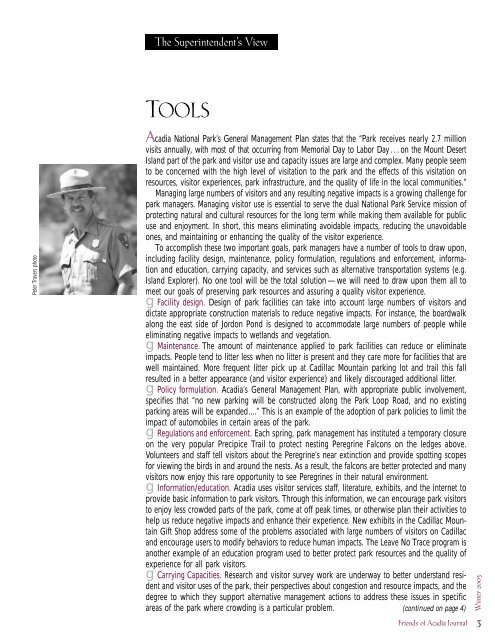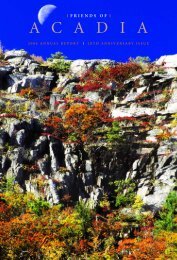graves' supermarkets - Friends of Acadia
graves' supermarkets - Friends of Acadia
graves' supermarkets - Friends of Acadia
You also want an ePaper? Increase the reach of your titles
YUMPU automatically turns print PDFs into web optimized ePapers that Google loves.
Peter Travers photo<br />
The Superintendent’s View<br />
TOOLS<br />
<strong>Acadia</strong> National Park’s General Management Plan states that the “Park receives nearly 2.7 million<br />
visits annually, with most <strong>of</strong> that occurring from Memorial Day to Labor Day...on the Mount Desert<br />
Island part <strong>of</strong> the park and visitor use and capacity issues are large and complex. Many people seem<br />
to be concerned with the high level <strong>of</strong> visitation to the park and the effects <strong>of</strong> this visitation on<br />
resources, visitor experiences, park infrastructure, and the quality <strong>of</strong> life in the local communities.”<br />
Managing large numbers <strong>of</strong> visitors and any resulting negative impacts is a growing challenge for<br />
park managers. Managing visitor use is essential to serve the dual National Park Service mission <strong>of</strong><br />
protecting natural and cultural resources for the long term while making them available for public<br />
use and enjoyment. In short, this means eliminating avoidable impacts, reducing the unavoidable<br />
ones, and maintaining or enhancing the quality <strong>of</strong> the visitor experience.<br />
To accomplish these two important goals, park managers have a number <strong>of</strong> tools to draw upon,<br />
including facility design, maintenance, policy formulation, regulations and enforcement, information<br />
and education, carrying capacity, and services such as alternative transportation systems (e.g.<br />
Island Explorer). No one tool will be the total solution — we will need to draw upon them all to<br />
meet our goals <strong>of</strong> preserving park resources and assuring a quality visitor experience.<br />
gFacility design. Design <strong>of</strong> park facilities can take into account large numbers <strong>of</strong> visitors and<br />
dictate appropriate construction materials to reduce negative impacts. For instance, the boardwalk<br />
along the east side <strong>of</strong> Jordon Pond is designed to accommodate large numbers <strong>of</strong> people while<br />
eliminating negative impacts to wetlands and vegetation.<br />
gMaintenance. The amount <strong>of</strong> maintenance applied to park facilities can reduce or eliminate<br />
impacts. People tend to litter less when no litter is present and they care more for facilities that are<br />
well maintained. More frequent litter pick up at Cadillac Mountain parking lot and trail this fall<br />
resulted in a better appearance (and visitor experience) and likely discouraged additional litter.<br />
gPolicy formulation. <strong>Acadia</strong>’s General Management Plan, with appropriate public involvement,<br />
specifies that “no new parking will be constructed along the Park Loop Road, and no existing<br />
parking areas will be expanded....” This is an example <strong>of</strong> the adoption <strong>of</strong> park policies to limit the<br />
impact <strong>of</strong> automobiles in certain areas <strong>of</strong> the park.<br />
gRegulations and enforcement. Each spring, park management has instituted a temporary closure<br />
on the very popular Precipice Trail to protect nesting Peregrine Falcons on the ledges above.<br />
Volunteers and staff tell visitors about the Peregrine’s near extinction and provide spotting scopes<br />
for viewing the birds in and around the nests. As a result, the falcons are better protected and many<br />
visitors now enjoy this rare opportunity to see Peregrines in their natural environment.<br />
gInformation/education. <strong>Acadia</strong> uses visitor services staff, literature, exhibits, and the internet to<br />
provide basic information to park visitors. Through this information, we can encourage park visitors<br />
to enjoy less crowded parts <strong>of</strong> the park, come at <strong>of</strong>f peak times, or otherwise plan their activities to<br />
help us reduce negative impacts and enhance their experience. New exhibits in the Cadillac Mountain<br />
Gift Shop address some <strong>of</strong> the problems associated with large numbers <strong>of</strong> visitors on Cadillac<br />
and encourage users to modify behaviors to reduce human impacts. The Leave No Trace program is<br />
another example <strong>of</strong> an education program used to better protect park resources and the quality <strong>of</strong><br />
experience for all park visitors.<br />
gCarrying Capacities. Research and visitor survey work are underway to better understand resident<br />
and visitor uses <strong>of</strong> the park, their perspectives about congestion and resource impacts, and the<br />
degree to which they support alternative management actions to address these issues in specific<br />
areas <strong>of</strong> the park where crowding is a particular problem. (continued on page 4)<br />
Winter 2003<br />
<strong>Friends</strong> <strong>of</strong> <strong>Acadia</strong> Journal 3





